Module 4 Carnival Reading 导学案-外研必修5精品
Module 4 Carnival Language points 导学案-外研必修5精品
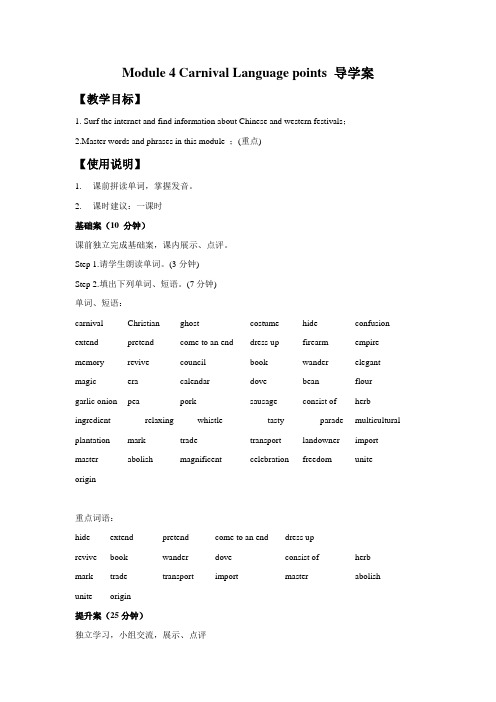
Module 4 Carnival Language points 导学案【教学目标】1. Surf the internet and find information about Chinese and western festivals;2.Master words and phrases in this module ;(重点)【使用说明】1. 课前拼读单词,掌握发音。
2. 课时建议:一课时基础案(10 分钟)课前独立完成基础案,课内展示、点评。
Step 1.请学生朗读单词。
(3分钟)Step 2.填出下列单词、短语。
(7分钟)单词、短语:carnival Christian ghost costume hide confusion extend pretend come to an end dress up firearm empire memory revive council book wander elegant magic era calendar dove bean flourgarlic onion pea pork sausage consist of herb ingredient relaxing whistle tasty parade multicultural plantation mark trade transport landowner import master abolish magnificent celebration freedom uniteorigin重点词语:hide extend pretend come to an end dress uprevive book wander dove consist of herbmark trade transport import master abolish unite origin提升案(25分钟)独立学习,小组交流,展示、点评[词语要点归纳]1. This is a festival of colors which marks the beginning of spring in India.分析:which此处引导非限制性定语从句。
外研社必修五Module_4《Carnival》reading the magic of masks导学案
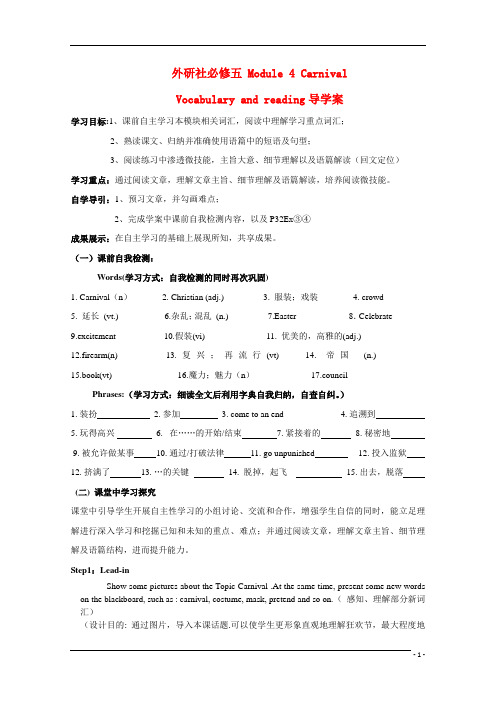
外研社必修五 Module 4 CarnivalVocabulary and reading导学案学习目标:1、课前自主学习本模块相关词汇,阅读中理解学习重点词汇;2、熟读课文、归纳并准确使用语篇中的短语及句型;3、阅读练习中渗透微技能,主旨大意、细节理解以及语篇解读(回文定位)学习重点:通过阅读文章,理解文章主旨、细节理解及语篇解读,培养阅读微技能。
自学导引:1、预习文章,并勾画难点;2、完成学案中课前自我检测内容,以及P32E x③④成果展示:在自主学习的基础上展现所知,共享成果。
(一)课前自我检测:Words(学习方式:自我检测的同时再次巩固)1. Carnival(n)_______2. Christian (adj.) ________3. 服装;戏装________4. crowd _________5. 延长(vt.) ________6.杂乱;混乱(n.) ________7.Easter ___________ 8.Celebrate _______ 9.excitement___________10.假装(vi)______________11. 优美的,高雅的(adj.)____________ 12.firearm(n)___________13.复兴;再流行(vt)______14. 帝国(n.) _________ 15.book(vt)__________ 16.魔力;魅力(n)___________ 17.council _________Phrases:(学习方式:细读全文后利用字典自我归纳,自查自纠。
)1. 装扮2. 参加3. come to an end_____________4. 追溯到5. 玩得高兴6. 在……的开始/结束7. 紧接着的8. 秘密地9. 被允许做某事10. 通过/打破法律11. go unpunished 12. 投入监狱12. 挤满了13. …的关键 14. 脱掉,起飞15. 出去,脱落(二) 课堂中学习探究课堂中引导学生开展自主性学习的小组讨论、交流和合作,增强学生自信的同时,能立足理解进行深入学习和挖掘已知和未知的重点、难点;并通过阅读文章,理解文章主旨、细节理解及语篇结构,进而提升能力。
外研版必修五Module-4--Carnival导学案
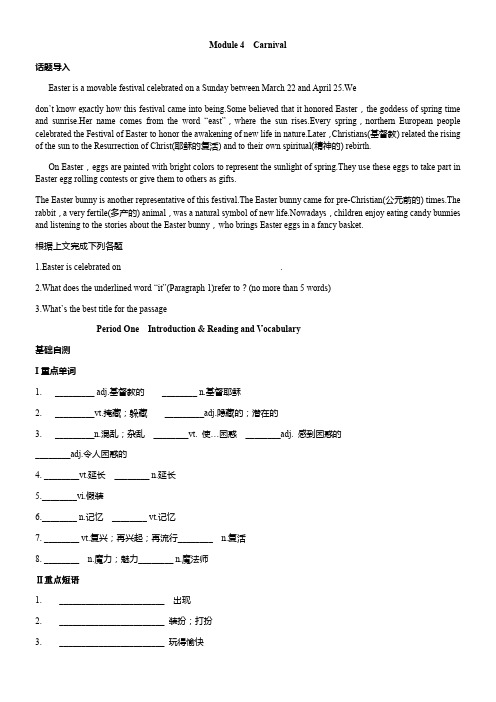
Module 4 Carnival话题导入Easter is a movable festival celebrated on a Sunday between March 22 and April 25.Wedon’t know exactly how this festival came into being.Some believed that it honored Easter,the goddess of spring time and sunrise.Her name comes from the word “east”,where the sun rises.Every spring,northern European people celebrated the Festival of Easter to honor the awakening of new life in ter,Christians(基督教) related the rising of the sun to the Resurrection of Christ(耶稣的复活) and to their own spiritual(精神的) rebirth.On Easter,eggs are painted with bright colors to represent the sunlight of spring.They use these eggs to take part in Easter egg rolling contests or give them to others as gifts.The Easter bunny is another representative of this festival.The Easter bunny came for pre-Christian(公元前的) times.The rabbit,a very fertile(多产的) animal,was a natural symbol of new life.Nowadays,children enjoy eating candy bunnies and listening to the stories about the Easter bunny,who brings Easter eggs in a fancy basket.根据上文完成下列各题1.Easter is celebrated on .2.What does the underlined word “it”(Paragraph 1)refer to?(no more than 5 words)3.What’s the best title for the passagePeriod One Introduction & Reading and Vocabulary基础自测I重点单词1. _________ adj.基督教的________ n.基督耶稣2. _________vt.掩藏;躲藏_________adj.隐藏的;潜在的3. _________n.混乱;杂乱________vt. 使…困惑________adj. 感到困惑的________adj.令人困惑的4. ________vt.延长________ n.延长5.________vi.假装6.________ n.记忆________ vt.记忆7. ________ vt.复兴;再兴起;再流行________ n.复活8. ________ n.魔力;魅力________ n.魔法师Ⅱ重点短语1. ________________________ 出现2. ________________________ 装扮;打扮3. ________________________ 玩得愉快4. ________________________ 结束5. ________________________ 连续地6. ________________________秘密地7. ________________________追溯到(某个时候)8. ________________________把某人投入监狱9. ________________________去掉;剥落10. ________________________ 把……看作……Ⅲ佳句积累1.________ carnival,and you will think of crowds,costumes,and confusion.想到狂欢节,你就会想到拥挤的人群,节日的服装和混乱的场景。
高中英语 Module4 Carnival单元重点词汇导学案 外研版必修5
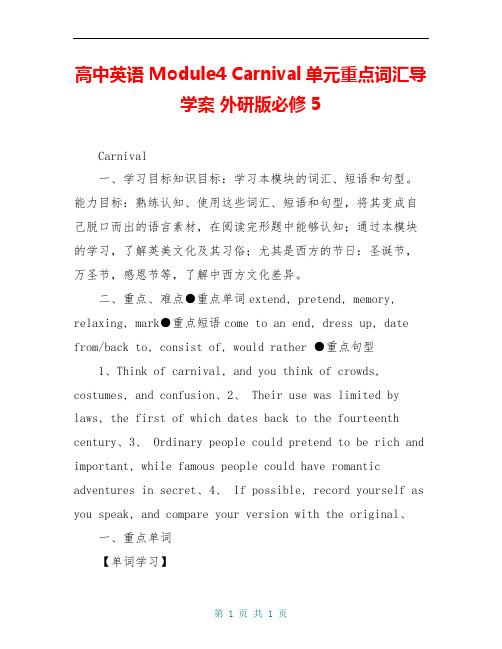
高中英语 Module4 Carnival单元重点词汇导学案外研版必修5Carnival一、学习目标知识目标:学习本模块的词汇、短语和句型。
能力目标:熟练认知、使用这些词汇、短语和句型,将其变成自己脱口而出的语言素材,在阅读完形题中能够认知;通过本模块的学习,了解英美文化及其习俗;尤其是西方的节日:圣诞节,万圣节,感恩节等,了解中西方文化差异。
二、重点、难点●重点单词extend, pretend, memory, relaxing, mark●重点短语come to an end, dress up, date from/back to, consist of, would rather ●重点句型1、Think of carnival, and you think of crowds, costumes, and confusion、2、 Their use was limited by laws, the first of which dates back to the fourteenth century、3、 Ordinary people could pretend to be rich and important, while famous people could have romantic adventures in secret、4、 If possible, record yourself as you speak, and compare your version with the original、一、重点单词【单词学习】1、extend v、延长,延伸,伸展,给予提供【例句】The bird extended its wings in flight、鸟儿展翅飞翔。
The road extends for miles and miles、这条路向远处绵延伸展。
【拓展】extend a warm welcome to sb、热烈欢迎某人extend from…to… 从……向……延伸extended family 大家庭extension n、伸长,延伸extensive adj、广大的,广泛的【例句】Moreover, the tool becomes an extension of yourself、而且,这种工具将成为您的扩展。
高中英语 Module4 Carnival(Period5)导学案 外研版必修5
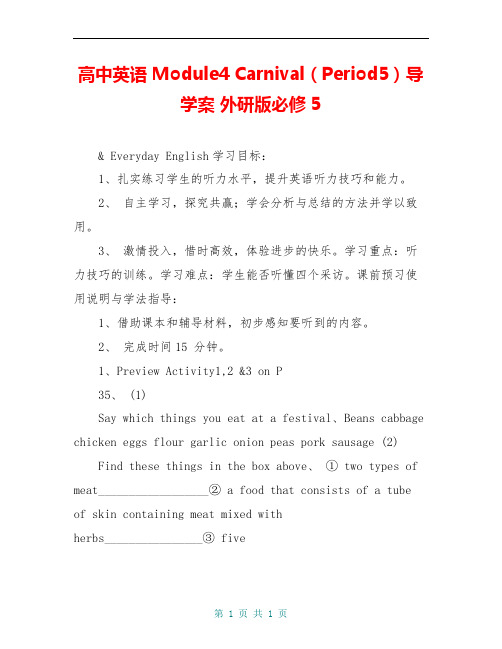
高中英语 Module4 Carnival(Period5)导学案外研版必修5& Everyday English学习目标:1、扎实练习学生的听力水平,提升英语听力技巧和能力。
2、自主学习,探究共赢;学会分析与总结的方法并学以致用。
3、激情投入,惜时高效,体验进步的快乐。
学习重点:听力技巧的训练。
学习难点:学生能否听懂四个采访。
课前预习使用说明与学法指导:1、借助课本和辅导材料,初步感知要听到的内容。
2、完成时间15 分钟。
1、Preview Activity1,2 &3 on P35、 (1)Say which things you eat at a festival、Beans cabbage chicken eggs flour garlic onion peas pork sausage (2) Find these things in the box above、① two types of meat__________________② a food that consists of a tube of skin containing meat mixed withherbs________________③ fivevegetables____________________④ two ingredients for making a cake_________________ (3)Pair work、 Add more vegetables and types of meat、VegetablesMeat2、 How much do you know about carnival? (Group work, write your answersbelow、)_________________________________________________ ______________________________3、 Do you know them?Carnival in RioMardi GrasNotting HillOktoberfest我的疑问:课内探究1、Pair work: Listen and finish Activity4 and5、(1)Match the interview with the pictures、(2)Fill in the table、 NameWhere?When?Howlong?OriginFoodCaitlinNew Orleans, USAJan、Feb、2months18th centuryKing CakesCameronNotting Hill, Londonlast weekend in Augustweekend1960schicken, rich and peasMariaRio, BrazilFebruary5 days1850pork, beans and garlicStefanGermanySept、—Oct、2 weeks1810sausages and sauerkuaut2、 Group work:① The French、② A plastic baby、③ Because of the weather、④ Caribbean immigrants to the UK、 Because it is an important festival for them、⑤ Because Carnivalis in the Brazilian’s blood、⑥ They go for a walk on the beach、⑦ Sausages、⑧ Ten million、3、 Blankfilling(1)beginning(2)brought(3)famous(4)ordinary(5)organ ize(6)blood(7)part(8)origins(9)competition(10)prefer4、 Post-listening (1)b (2)a (3)b (4)a (5)b (6)a (7)a (8)b课后巩固1、Went wild2、 Highest spot3、 In the blood4、 In secret5、 More or less。
高中英语 Module4 Carnival(Period3)导学案 外研版必修5

高中英语 Module4 Carnival(Period3)导学案外研版必修5points in Reading学习目标:1、扎实掌握本课文中词汇和短语,提升综合语言运用能力。
2、自主学习,探究共赢;学会分析与总结的方法并学以致用。
3、激情投入,惜时高效,体验进步的快乐。
学习重点:重点词汇、短语的学以致用。
学习难点:重点动词和短语的正确运用。
课前预习学法指导:1、借助课本和辅导材料,深入理解文章并尝试总结知识结构。
2、完成时间15分钟。
教材助读:学习建议:认真思考,理解并尝试总结下列词汇的用法。
1、In Europe, where it began, carnival was followed by forty days without meat as people prepared for the Christian festival Easter、(P32)Prepare v、准备,预备1) prepare sth 准备某事2)prepare to do sth、准备做某事3)prepare for sth、为某事做准备(get ready for .../ make pr eparations for (4)prepare sb for sth使某人对某事有所准备5)be (well)prepared for …= be ready for sth做好了……的心理准备即讲即练:1)全班都在努力用功准备考试。
_________________________________________________________ __________2)下次我们会准备得更充分。
_________________________________________________________ __________2、 Having fun meant eating, drinking, and dressing up、(P32)dress v、穿衣服dress up 穿上盛装,穿上正式服装,装扮,乔装打扮dress sb 给某人穿衣服be dressed in … 穿着……dress n、衣服,服装/ 礼服,裙子[C] a full/evening dress 全礼服/晚礼服词语辨析:Dress 动作人人+ be dressed in + 衣服Wear状态衣服、饰品表留发、蓄胡、面露某种表情Put on动作衣服、鞋袜意为穿上,表动作Have on状态衣服无进行时和被动语态即讲即练:1)_______in red, the girl looks more beautiful、A、 DressingB、 DressedC、 To dressD、 Having dressed【解析】选B。
Module 4 Carnival Language points 导学案-外研必修5精品
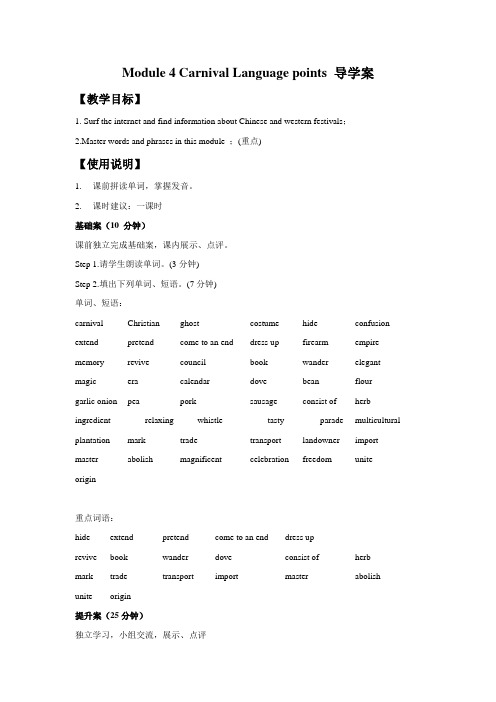
Module 4 Carnival Language points 导学案【教学目标】1. Surf the internet and find information about Chinese and western festivals;2.Master words and phrases in this module ;(重点)【使用说明】1. 课前拼读单词,掌握发音。
2. 课时建议:一课时基础案(10 分钟)课前独立完成基础案,课内展示、点评。
Step 1.请学生朗读单词。
(3分钟)Step 2.填出下列单词、短语。
(7分钟)单词、短语:carnival Christian ghost costume hide confusion extend pretend come to an end dress up firearm empire memory revive council book wander elegant magic era calendar dove bean flourgarlic onion pea pork sausage consist of herb ingredient relaxing whistle tasty parade multicultural plantation mark trade transport landowner import master abolish magnificent celebration freedom uniteorigin重点词语:hide extend pretend come to an end dress uprevive book wander dove consist of herbmark trade transport import master abolish unite origin提升案(25分钟)独立学习,小组交流,展示、点评[词语要点归纳]1. This is a festival of colors which marks the beginning of spring in India.分析:which此处引导非限制性定语从句。
2019-2020年外研版高中英语必修五Module4Carnival全模块最新精品导学案设计附课后
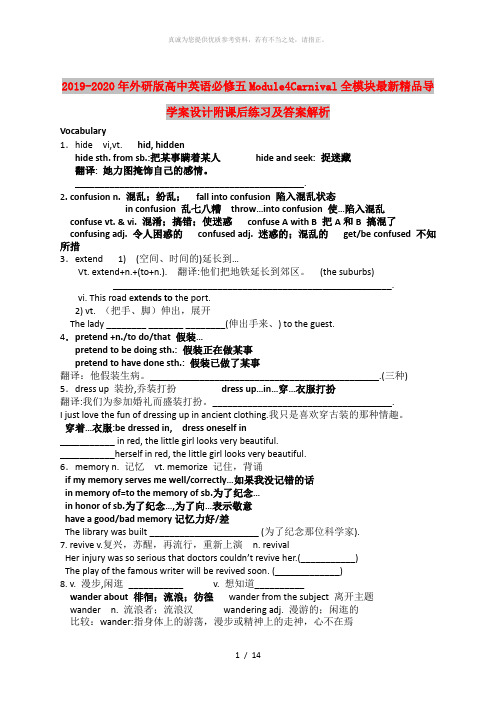
2019-2020年外研版高中英语必修五Module4Carnival全模块最新精品导学案设计附课后练习及答案解析Vocabulary1.hide vi,vt. hid, hiddenhide sth. from sb.:把某事瞒着某人hide and seek: 捉迷藏翻译: 她力图掩饰自己的感情。
______________________________________________.2. confusion n. 混乱;纷乱;fall into confusion 陷入混乱状态in confusion 乱七八糟throw…into confusion 使…陷入混乱confuse vt. & vi. 混淆;搞错;使迷惑confuse A with B 把A和B 搞混了confusing adj. 令人困惑的confused adj. 迷惑的;混乱的get/be confused 不知所措3.extend 1) (空间、时间的)延长到…Vt. extend+n.+(to+n.). 翻译:他们把地铁延长到郊区。
(the suburbs)________________________________________________________.vi. This road e xtends to the port.2) vt. (把手、脚)伸出,展开The lady ________ _______ ________(伸出手来、) to the guest.4.pretend +n./to do/that 假装…pretend to be doing sth.: 假装正在做某事pretend to have done sth.: 假装已做了某事翻译:他假装生病。
______________________________________________.(三种) 5.dress up 装扮,乔装打扮dress up…in…穿…衣服打扮翻译:我们为参加婚礼而盛装打扮。
高中英语 Module4 Carnival导学案 外研版必修5
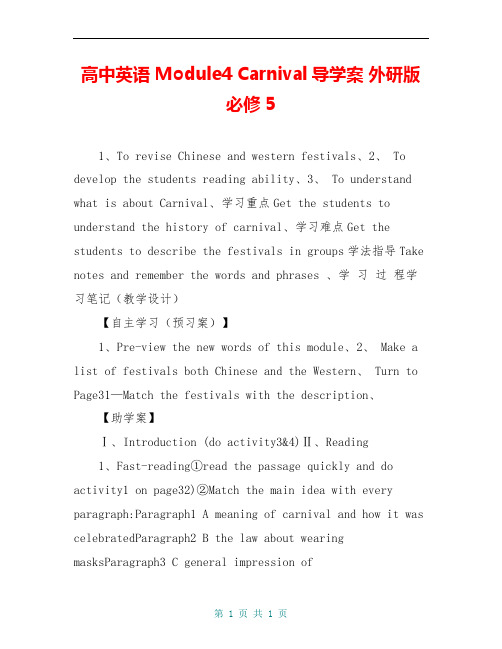
高中英语 Module4 Carnival导学案外研版必修51、To revise Chinese and western festivals、2、 To develop the students reading ability、3、 To understand what is about Carnival、学习重点Get the students to understand the history of carnival、学习难点Get the students to describe the festivals in groups学法指导Take notes and remember the words and phrases 、学习过程学习笔记(教学设计)【自主学习(预习案)】1、Pre-view the new words of this module、2、 Make a list of festivals both Chinese and the Western、 Turn to Page31—Match the festivals with the description、【助学案】Ⅰ、Introduction (do activity3&4)Ⅱ、Reading1、Fast-reading①read the passage quickly and do activity1 on page32)②Match the main idea with every paragraph:Paragraph1 A meaning of carnival and how it was celebratedParagraph2 B the law about wearing masksParagraph3 C general impression ofcarnivalParagraph4 D how it is celebrate today in Venice and the feature of itParagraph5 E carnival in Venice and the problem it caused Paragraph6 F the revival of the tradition of celebrating it、2、Careful reading①Read the passage carefully and do activity2 on page32、②Read the passage and answer the questions、1、Where does Carnival come from? What does it mean?2、 When was it celebrated?3、 Where was the most famous Carnival in Europe?4、 How long did the first Carnival in Venice last? What about now?5、 Did the government of Venice encourage the wearing of masks?6、 Who started the Carnival again, tourists or students?Ⅲ、Language points1、重点词汇:1 hide vt、 & vi、掩藏,躲藏;隐瞒,掩盖(尤指感情)hide sth/sb (from sb)对某人隐瞒/隐藏…… keep sth hidden 把某物藏起来hidden meaning 言外之意2、 pretend vi、 & vt、假装;(在游戏中)装扮pretend (to do)sth假装(干)某事pretend to be doing… 假装正在做……pretend to have done… 假装做了……pretend that… 假装……3mark n、分数,得分;记号,标志;痕迹 v、标志(着);做标记;弄污;庆贺;打分;注意mark…with…用……做标记 make a mark 做标记 get a high/good/low/poor mark 得高/低分4 memory n、[U][C]记忆,记忆力,回忆;(计算机)内存 have agood/bad memory for sth能记住/记不住in memory of…=to the memory of… 为纪念…… from memory 凭记忆,根据记忆bring back memories 唤起回忆【经典句式】If my memory serves me correctly/right…如果我没有记错的话……2、重点短语1 go unpunished 未被惩罚 go unnoticed未被注意 go unreported 未被报道 go too far 太过分 go wild/mad/bad/deaf/angry发疯了/变质了/变坏了/聋了/生气了go well/smoothly 进展顺利 as the saying goes 正如名言所说2 dress up 装扮;打扮 dress up in sth穿上盛装;化妆,打扮dress sb up as… 把某人打扮成…… be dressed in… 穿着……3、重点句型:The arrival of Europeans in America, and the opening of huge farms and plantations to grow cotton,fruit and vegetables,meant there was an immediate need for people to work on them、欧洲人到达美洲大陆以及大型棉花、水果和蔬菜农场和庄园的开垦意味着急需人员在那里劳动。
Module4Carnival教案外研版必修5(精)

Module 4 CarnivalPeriod OneTeaching aims:1. To revise Chinese and western festivals.2. To develop the students reading ability.3. To understand what is about Carnival.Important and difficult points:1 Get the students to understand the history of carnival.2 Get the students to describe the festivals in groups.Teaching procedures:Step 1. Revision.Read the new words of this passage.Step 2. Introduction1. We have learned many festivals both Chinese and the Western. What festivals do you know? Divide the class into 2 groups. One group is for Chinese Festivals, the other group is for Western festivals.Make a list of them on the blackboard..2. Turn to Page 31— Match the festivals with the description.Step 3. Lead-inToday we will learn another festival ---- Carnival. It originates from Europe, and during thesedays, people often love wearing special clothes and masks for it.Step 4. Fast-readingMatch the main idea with every paragraph.Paragraph 1 A meaning of carnival and how it was celebratedParagraph 2 B the law about wearing masksParagraph 3 C general impression of carnivalParagraph 4 D how it is celebrate today in Venice and the feature of it Paragraph 5 E carnival in Venice and the problem it causedParagraph 6 F the revival of the tradition of celebrating it.(Answers: 1— 6 CAEBFDStep 5. Further-readingRead the passage and answer the questions.1. Where does Carnival come from? What does it mean?2. When was it celebrated?3. Where was the most famous Carnival in Europe?4. How long did the first Carnival in Venice last? What about now?5. Did the government of Venice encourage the wearing of masks?6. Who started the Carnival again, tourists or students?(Answers: 1. “Carnival” comes from two Latin words, meaning “no more meat”. 2. It began just after Christmas. 3. The most famous carnival in Europe was in Venice. 4. At the beginning, it lasted for just one day. 5. No. 6. The students started the Carnival. Step 6. VocabularyActivity 1: Read through the words in the box and have the students repeat them individually. Ask the students to complete the task individually, then check with a partner. Check the answers together:(Answers: 1. confusion 2. excitement 3. mask 4. mystery 5. magic 6. costume 7. crowd 8. tradition 9. atmosphereActivity 2: Choose the correct meanings of the words and phrases.Check the answers one by one.(Answers: 1— 4 babb 5— 8 abbbStep 7. DiscussionDiscuss in groups of four.1. What is the feature of carnival in Venice?2. Which is your favourite festival?Step 8. Homework1. Workbook— on Page 87.Read the passage and match the headings with the text.2. Write a short passage about your favorite festival.Period TwoTeaching aims:1. To listen to the description about western customs.2. To express likes, dislikes and preferences:(1 I love doing…;(2 I don’t like…; I hate…; I dislike…; I don’t care much for(3 I prefer…to…; I prefer doing …(4 I’d rather…than…(5 I an interested in…3. To learn several phrases.Difficult and important points:1. Get the students to express likes and dislikes2. Learn to use the phrases: give up; go wild ;more or less; high spot; funnily enough; in your blood; wash down; walk offTeaching procedures:Step 1. RevisionCheck the homework.— Ask several students to read the short passage with the name of My Favorite Festival.Step 2. Vocabulary1. Read the words about food.2. Now say which things you eat at a festival.3. Practice.Activity 2: Find these things in the box in Activity 1.(1 Two type of meat ((2 a food that consists of a tube of skin containing meat mixed with herbs. ((3 five vegetables ((4 two ingredients for making a cake ((Answers: (1 pork and chicken (2 sausages (3 beans, cabbages, garlic, onion, peas (4 flour, eggsStep 3. ListeningBefore listening— Look at the photos in Activity 4 and tell them every picture meaning a special festival..While listening— Listen to the tape twice and match the names of the festivals with the photos.After Listening:Complete the tableStep 4. Everyday English1. Read the sentences and choose the correct meaning of the words and phrases.2. Check the answers one by one. (1-b (2 a (3 b (4a (5 b (6 a (7a (8b3. Explain the words and phrases.(1give up sth. =don’t have it any more(2 go/wild with joy 欣喜若狂(3 more or less =approximately (oppositeexactly.Eg: That is approximately correct.(4 high spot= the best part(5 be/run in sb.`s blood = be /run in the blood. 生来就有的(因遗传或环境影响eg; Most of my family are teachers, it runs in the blood.(6 wash down a meal = have a drinkwalk off a meal = help the food go down by walking.Step 5. Function1. Match the sentences with the speakers. Say what they are speaking about.(1Caitlin: King Cake(2Maria: Feijoada(3 Stefan: saugages(4 Cameron: traditional Jamaican food – chicken with rice and peas.2. Number the phrases from the most negative to the most positive(1 Ask the students to do this individually.(2 Call the answers back from the whole class, one at a time, from 1--6(3 Write down them on the blackboard:3. Work in pairs. Discuss your preferences for food to eat at festival. Use the phrases in Activity2.(1 Read the example with the class.(2 Pair the students to discuss their preferences.(3 Circulate and monitor their production.Step 6. HomeworkFinish off the workbook.Period ThreeTeaching aims:1. To learn more about carnival.2. To teach them how to write an e-mail.3. To develop the students’ reading skills.Difficult and important points:1. Get the students to learn to write an e-mail.2. Get the students to understand some important sentences.Teaching procedures:Step 1. RevisionRead the words and have a dictation.Step 2. Lead-inWhat do you remember about carnival?Where did it start first?Step 3. Fast-reading:Read and underline the topic sentences ( use your own words about every paragraph. Paragraph1: We can understand what carnival is all about by reading the history of America and the meeting of two cultures.Paragraph2: The slave trade brought millions of black people to the new world. Paragraph3: The slaves were forced to watch their European masters to celebrate carnival and then they began to hold carnival with their own features.Paragraph4: Carnival became a celebration of freedom.Paragraph5: As time went on, carnival became a way of uniting different communities and now it has become a celebration of life itself.Step 4. Further reading1. What did marked the beginning of the slave trade?2. How were millions of people taken to work as slaves?3. How did the slaves begin to hold their own carnival in Trinidad?4. When was the slave trade abolished?5. How was carnival changed when the slave trade was abolished?6. When did carnival become a way to unite different communities?(Answers: 1 That the arrival of European in America, and the opening of huge farms and plantations to grow cotton, fruit and vegetables, meant there was an immediate need to people to work on them marked the beginning of the slave trades. 2 Millions of people were taken by force from their homes in America and transported to the New World to work as slaves? 3. They painted their faces white, imitating their masters and making fun of them. 4. The slave trade was abolished in 1838. 5. It became more colourful and more exciting than it had been before. 6. As people forgot their everyday problems and enjoyed themselves eating, drinking, and dancing.Step 5. Several phrases(1 by force (2 be forced to do (3make fun of sb. (4 bring good luck (5 take over (6 take part in (7 become a celebration of freedom (8 with the time passing Step 6. Discussion1. What is the meaning of carnival?2. Which Chinese festival is most like carnival?Step 7. Reading and writingActivity1. Read the email and number the things in the order you read them1. Read through the things with the whole class and make sure that they understand them all.2. Ask them to read the email and order the things individually, then check with a partner.3. Call back the answers from the whole class, in order.(Answers: 1. the atmosphere at the festival 2. the music 3. the food 4. what the writer’s doing5. what the writer’s going to doActivity2. Underline the adjectives used to describe.1. the atmosphere: noisy/ colourful2. the music: great/ exciting/ relaxing3. the food: good/ tastyActivity3 Write an email from a Chinese festival. Make sure of the details about:1. the atmosphere2. the music3. the foodStep 8. HomeworkWrite a description of the festival for visitors to China.( For example: Spring Festival Period FourTeaching aims:1. To learn new words and expressions and learn how to use them.2. To review of the passive voices.Difficult and important points:1. Get the students to know how to use passive voices:一般现在时和一般过去时的被动语态2. The usage of: hide, pretend, memory, wander, come to an end, dress up; consist of be good for ,date from.Teaching procedures:Step 1. RevisionRead the sentences and find out what grammar are they?1. Is the room cleaned every day?2. We were woken up by a loud noise during the night.3. Something must be done before it is too late.4. Have you heard the news? The President has been shot?5. The car was three years old but hadn’t been used very much.6. There’s somebody walking behind us. I think we are being followed.Step 2. Presentation—被动语态被动语态的基本形式是 : be +过去分词根据时态的不同 , be的形式有所变化 .(1 一般现在时的被动语态 : am/is /are+过去分词 (口语可用 get/become或 got /became(2 一般过去时的被动语态 :was /were+过去分词被动语态的基本用法 :不知道或没有必要提到动作的执行者是谁时用被动语态 . 强调或突出动作的承受者常用被动语态 .(有时可省略 .使用被动语态应注意的几个问题 .(1 主动变被动时双宾语的变化 . 看下列例句eg: 我朋友在我生日时送我一本有趣的书 .My friend gave me an interesting book on my birthday.— An interesting book was given to me (by my friend on my birthday.— I was given an interesting book (by my friend on my birthday.(2 主动变被动时 , 宾补成主补 (位置不变 ; 作宾补的省略 to 的不定时在被动语态中应加 to. eg: 老板让他整天工作 .The boss made him work all day long.— He was made to work all day long (by the boss.(3 短语动词变被动语态时 , 勿要掉”尾巴”.eg: 孩子们被他照顾的很好 .— The children were taken good care of ( by her.eg: 要注意一下你的发音和拼写 .— Your pronunciation and spelling should be paid attention to.(4 情态动词和 be going to, be to, be sure to ,used to, have to, had better等结构变被动语态 , 只需将它们后面的动词原形变为 be +过去分词。
外研版必修五Module 4 Carnival导学案精编版
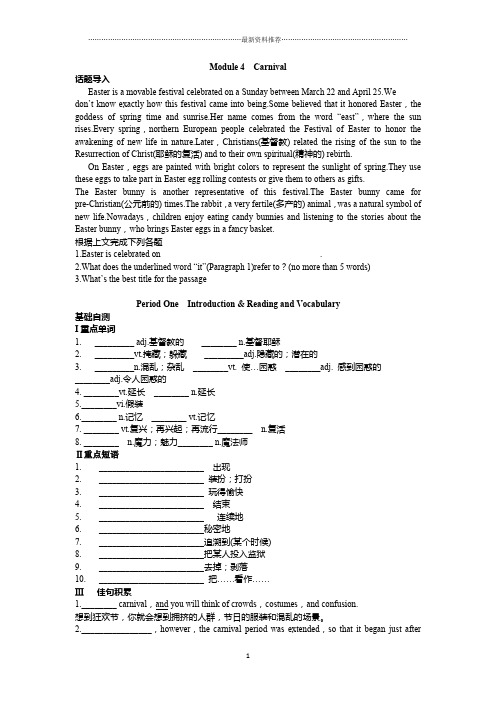
Module 4 Carnival话题导入Easter is a movable festival celebrated on a Sunday between March 22 and April 25.We don’t know exactly how this festival came into being.Some believed that it honored Easter,the goddess of spring time and sunrise.Her name comes from the word “east”,where the sun rises.Every spring,northern European people celebrated the Festival of Easter to honor the awakening of new life in ter,Christians(基督教) related the rising of the sun to the Resurrection of Christ(耶稣的复活) and to their own spiritual(精神的) rebirth.On Easter,eggs are painted with bright colors to represent the sunlight of spring.They use these eggs to take part in Easter egg rolling contests or give them to others as gifts.The Easter bunny is another representative of this festival.The Easter bunny came for pre-Christian(公元前的) times.The rabbit,a very fertile(多产的) animal,was a natural symbol of new life.Nowadays,children enjoy eating candy bunnies and listening to the stories about the Easter bunny,who brings Easter eggs in a fancy basket.根据上文完成下列各题1.Easter is celebrated on .2.What does the underlined word “it”(Paragraph 1)refer to?(no more than 5 words)3.What’s the best title for the pa ssagePeriod One Introduction & Reading and Vocabulary基础自测I重点单词1. _________ adj.基督教的________ n.基督耶稣2. _________vt.掩藏;躲藏_________adj.隐藏的;潜在的3. _________n.混乱;杂乱________vt. 使…困惑________adj. 感到困惑的________adj.令人困惑的4. ________vt.延长________ n.延长5.________vi.假装6.________ n.记忆________ vt.记忆7. ________ vt.复兴;再兴起;再流行________ n.复活8. ________ n.魔力;魅力________ n.魔法师Ⅱ重点短语1. ________________________ 出现2. ________________________ 装扮;打扮3. ________________________ 玩得愉快4. ________________________ 结束5. ________________________ 连续地6. ________________________秘密地7. ________________________追溯到(某个时候)8. ________________________把某人投入监狱9. ________________________去掉;剥落10. ________________________ 把……看作……Ⅲ佳句积累1.________ carnival,and you will think of crowds,costumes,and confusion.想到狂欢节,你就会想到拥挤的人群,节日的服装和混乱的场景。
高中英语 Module4 Carnival学案 外研版必修5

高中英语 Module4 Carnival学案外研版必修5Carnival 学案核心词汇1、Now more and more schools are trying to____________(扩大)their school yards to admit more students、2、He ____________(假装)that he was ill so that he could stay at home、3、The United Kingdom____________(由……构成)of Great Britain and Northern Ireland、4、They will ____________(传递)passengers from Beijing to Shanghai、5、She was ____________(漫步)aimlessly up and down the road、6、She is in a state of mental ____________(错乱)、7、The ____________(宏伟的)scene of the waterfall is a perfect delight to the eyes、8、Hearing the news our failing spirits____________(振作)、9、Fishing is his favourite____________、He knows it helps to ______________ him and many people else also find fishing ____________ and they often wear a ____________ smile after catching a fish、(relax)10、We’d like to __________ his birthday and the ____________ will be held in the hall、(celebrate)1、extend2、pretended3、consists4、transport,5、wandering6、confusion7、magnificent8、revived9、relaxation;relax;relaxing;relaxed10、celebrate;celebration高频短语1、________________ 结束;完结2、________________ 装扮;打扮3、________________ 接手,接管4、________________ 由……组成;由……构成5、________________ 放弃6、________________ 过得愉快7、________________ 追溯到8、________________ 几乎,差不多;大约9、________________ 连续地;不断地10、________________ 秘密地;暗地里11、________________ 变得疯狂12、________________ 冲洗某物,冲下13、________________ 用暴力,迫使14、________________ 捉弄,取笑1ZZZe to an end2、dress up3、take over4、consist of,5、give up6、have fun7、date back to8、more or less9、on end10、in secret11、go wild12、wash、、、down13、by force14、make fun of重点句式1、________________,________ you think of crowds,costumes and confusion、想到狂欢节,你自然就会想起拥挤的人群,节日的服饰及混乱的场景。
高中英语 Module4 Carnival(Period4)导学案 外研版必修5

高中英语 Module4 Carnival(Period4)导学案外研版必修5(Review of the Passive Voice)学习目标:1、扎实复习本模块语法被动语态,提升综合语言运用能力。
2、自主学习,探究共赢;学会分析与总结的方法并学以致用。
3、激情投入,惜时高效,体验进步的快乐。
学习重点:被动语态。
学习难点:被动语态的正确运用。
课前预习学法指导:1、借助课本和辅导材料,初步感知被动语态。
2、完成时间15分钟。
教材助读:被动语态(一)语态分类英语动词有两种语态,主动语态和被动语态。
主动语态表示主语是动作的执行者,被动语态表示主语是动作的承受者。
如:Mark Twain wrote this book、 (主动)This book was written by Mark Twain、(被动)He is feeding a dog、(主动)A dog is being fed by him、 (被动)被动语态结构:助动词be + 及物动词的过去分词构成。
(二)被动语态的时态、人称和数的变化主要体现在be的变化上,其形式与系动词be的变化形式完全一样。
以do 为例,如下:一般现在时:am / is / are + done 一般过去时:was / were +done 一般将来时:shall / will + done 一般过去将来时:should / would + done 现在进行时:am / is / are + being + done过去进行时:was / were + being + done 现在完成时:have / has + been + done过去完成时:had + been + done 将来完成时:shall / will + have been + done过去将来完成时:should / would + have been + done[注]被动语态没有将来进行时和过去将来进行时。
Module 4 Carniva 导学案-外研必修5精品
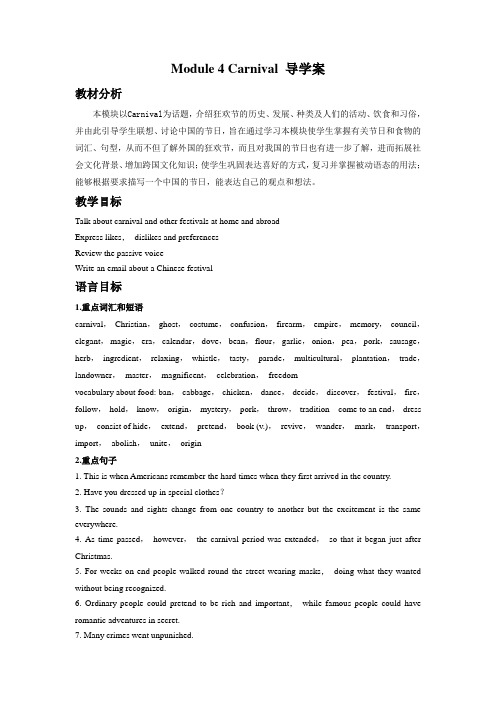
Module 4 Carnival 导学案教材分析本模块以Carnival为话题,介绍狂欢节的历史、发展、种类及人们的活动、饮食和习俗,并由此引导学生联想、讨论中国的节日,旨在通过学习本模块使学生掌握有关节日和食物的词汇、句型,从而不但了解外国的狂欢节,而且对我国的节日也有进一步了解,进而拓展社会文化背景、增加跨国文化知识;使学生巩固表达喜好的方式,复习并掌握被动语态的用法;能够根据要求描写一个中国的节日,能表达自己的观点和想法。
教学目标Talk about carnival and other festivals at home and abroadExpress likes,dislikes and preferencesReview the passive voiceWrite an email about a Chinese festival语言目标1.重点词汇和短语carnival,Christian,ghost,costume,confusion,firearm,empire,memory,council,elegant,magic,era,calendar,dove,bean,flour,garlic,onion,pea,pork,sausage,herb,ingredient,relaxing,whistle,tasty,parade,multicultural,plantation,trade,landowner,master,magnificent,celebration,freedomvocabulary about food: ban,cabbage,chicken,dance,decide,discover,festival,fire,follow,hold,know,origin,mystery,pork,throw,tradition come to an end,dress up,consist of hide,extend,pretend,book (v.),revive,wander,mark,transport,import,abolish,unite,origin2.重点句子1. This is when Americans remember the hard times when they first arrived in the country.2. Have you dressed up in special clothes?3. The sounds and sights change from one country to another but the excitement is the same everywhere.4. As time passed,however,the carnival period was extended,so that it began just after Christmas.5. For weeks on end people walked round the street wearing masks,doing what they wanted without being recognized.6. Ordinary people could pretend to be rich and important,while famous people could have romantic adventures in secret.7. Many crimes went unpunished.8. If they broke the laws,they were put into prison for up to two years.9. There must be a million people here.10. With the passing of time,the white inhabitants of the island began to take part in the carnival,too.能力目标Enable the students to talk about some foreign festivals and customs.教学重难点How to talk about festivals and customs at festivals and how to express likes,dislikes and preferences.教学过程Period 1 vocabulary and SpeakingCan you name the Chinese festivals or holidays?1. 春节_______________________________________ (lunar January 1)couplet对联fireworks 烟花fireworks爆竹paper- cuts剪纸lucky/gift money压岁钱2. 元宵节_____________________________________ (Lunar January 15)lion/dragon dance舞狮/龙riddles written on lanterns灯谜exhibit of lanterns灯会rice glue ball元宵/汤圆3. 清明节_____________________________________ (Lunar April 5)sweep and weed graves扫墓/除杂草kite flying放风筝4. 端午节____________________ (Lunar May 5) rice dumplings棕子Dragon Boat race龙舟赛5. 七夕_______________________________________ (Lunar July 7)Cowherd牛郎Girl Weaver织女the Milky Way银河magpie 喜鹊6. 中秋节_____________________________________ (Lunar August 15)Chang E flying to the moon嫦娥奔月moon cake月饼7. 重阳节_____________________________________(Lunar September 9)ascending a height登高enjoying the flourishing chrysanthemum [kri'sænθəməm]赏菊8. 除夕New Year' Eve (Lunar December 31)I. Festivals in other countries:1. 圣诞节_____________________________________ (25th December)Santa Claus圣诞老人Christmas tree圣诞树present礼物stocking长筒袜reindeer驯鹿sleigh雪橇This is a Christian festival which comes in the middle of winter.2. 情人节_____________________________________ (14th February) Chocolate巧克力rose 玫瑰3. 愚人节_____________________________________ (1st April)4. 胡里节Holi (11th March)This is a festival of color,which marks the beginning of spring in India.They paint all kinds of colors on their faces,singing and dancing to welcome the coming of the spring.5. 感恩节_____________________________________ (The 4th Thursday in November)turkey火鸡pumpkin南瓜pie派/馅饼This is when Americans remember the hard times when they first arrived in the country.6. 万圣节前夕_______________________ (31th. October) All Saints' Day (1st November)This festival is at the end of October,when ―ghosts‖ come out7. 复活节___________________________ (March 23 to April 25)Easter eggs复活节彩蛋Easter Bunny复活节小兔子This is a Christian holiday in March or April when Christians remember the death of Christ andhis return to life.8. 狂欢节/嘉年华会___________________People love wearing special clothes for this festival.II. Writing and speaking:What is your favorite festival?My favorite festival is …When is it celebrated?It’s celebrated in/on ….Why do you like it?I like it because ….What do you do this day?wear special clothes,eat special food,give or receive gifts,have a holiday from schooltake part in a traditional ceremony,dance and listen to music,enjoy yourself with friends or family______________________________________________________________________________________________________________________________________________________________________________________________________________________________________________________________________________________________________________________________________________________________________________________________________________________________________________________III. Book 5,Page 31,① Match the festival with the descriptions.Period 2&3 Reading and Vocabulary: The Magic of the MaskI. Brain storming: Look at the pictures of festivals and tell their English name.Carnival嘉年华是英文单词Carnival的中文译音,这个美丽的中文名字源于《圣经》中的一个故事:有一个魔鬼把耶稣困在旷野里,40天没有给耶稣吃东西,耶稣虽然饥饿,却没有接受魔鬼的诱惑。
Module 4《Carnival》Reading教案4(外研版必修5)

Module 4 CarnivalPeriod 2 Reading----The magic of the maskTeaching Goals:1. Students can learn about the development of carnival2. Students can develop their basic reading skills.3. Students can know the western festival---Carnival, by knowing other’s festival , we come to know our own festival more clearly, students learn to view the world in a multicultural vision.Teaching key point and difficult point:1. The key point of this lesson is to develop students’ scanning and skimming skills.2. The difficult point of this lesson is some difficult words and phrases . Teaching methods:1. Communicative teaching method2. Task-based” teaching method3.Cooperative learning methodTeaching equipment:multi-media computer, tape recorderTeaching Procedures:Step 1 Lead inPurpose: To arouse Ss’ interest in learning about the festivals.1. Ask Ss to name some chinese festivals.2. Small discussion:Which one is your favorite Chinese festival?3. Ask Ss to name the foreign festivals in the pictures.Step 2 ReadingPurpose: To develop some basic reading skills and get some information about carnival.Task1. Listen to the tape and choose the topics of the text.Task 2. Skim the text and match the topics with the paragraphs.Task 3. Scan the text and answer the detailed questions.Task 4. Read the text carefully and fill in the blank.Task 5. Test about the readingStep 3 Key pointsPurpose: This step is a practice section, aims to demonstrate their own ability of using language to do things.1.Think of carnival, and you think of crowds, costumes, and confusion.2.In Europe, where it began , carnival was followed by forty dayswithout meat,as people prepared for the Christian festival of Easter.3.Having fun meant eating ,drinking and dressing up.4.Ordinary people could pretend to be rich and important, while famouspeople could have romantic adventures in secret .Step 4 Retelling the textPurpose: Enable Ss to learn about the details of text and help them to talk about carnival. Let them to know what they have learnt during the class.Step 5 Homework1.Activity 3 on P32 and Activity 4 on P33.2.Finish V ocabulary exercises in WB .。
外研版必修五Module_4__Carnival导学案

Module 4 Carnival话题导入Easter is a movable festival celebrated on a Sunday between March 22 and April 25.Wedon’t know exactly how this festival came into being.Some believed that it honored Easter,the goddess of spring time and sunrise.Her name comes from the word “east”,where the sun rises.Every spring,northern European people celebrated the Festival of Easter to honor the awakening of new life in ter,Christians(基督教) related the rising of the sun to the Resurrection of Christ(耶稣的复活) and to their own spiritual(精神的) rebirth.On Easter,eggs are painted with bright colors to represent the sunlight of spring.They use these eggs to take part in Easter egg rolling contests or give them to others as gifts.The Easter bunny is another representative of this festival.The Easter bunny came for preChristian(公元前的) times.The rabbit,a very fertile(多产的) animal,was a natural symbol of new life.Nowadays,children enjoy eating candy bunnies and listening to the stories about the Easter bunny,who brings Easter eggs in a fancy basket.根据上文完成下列各题1.Easter is celebrated on .2.What does the underlined word “it”(Paragraph 1)refer to?(no more than 5 words)3.What’s the best title for the passagePeriod One Introduction & Reading and Vocabulary基础自测I重点单词1. _________ adj.基督教的________ n.基督耶稣2. _________vt.掩藏;躲藏_________adj.隐藏的;潜在的3. _________n.混乱;杂乱________vt. 使…困惑________adj. 感到困惑的________adj.令人困惑的4. ________vt.延长________ n.延长5.________vi.假装6.________ n.记忆________ vt.记忆7. ________ vt.复兴;再兴起;再流行________ n.复活8. ________ n.魔力;魅力________ n.魔法师Ⅱ重点短语1. ________________________ 出现2. ________________________ 装扮;打扮3. ________________________ 玩得愉快4. ________________________ 结束5. ________________________ 连续地6. ________________________秘密地7. ________________________追溯到(某个时候)8. ________________________把某人投入监狱9. ________________________去掉;剥落10. ________________________ 把……看作……Ⅲ 佳句积累1.________ carnival,and you will think of crowds,costumes,and confusion.想到狂欢节,你就会想到拥挤的人群,节日的服装和混乱的场景。
- 1、下载文档前请自行甄别文档内容的完整性,平台不提供额外的编辑、内容补充、找答案等附加服务。
- 2、"仅部分预览"的文档,不可在线预览部分如存在完整性等问题,可反馈申请退款(可完整预览的文档不适用该条件!)。
- 3、如文档侵犯您的权益,请联系客服反馈,我们会尽快为您处理(人工客服工作时间:9:00-18:30)。
Module 4 Carnival Reading 导学案【教学目标】1. Surf the internet and find information about Chinese and western festivals;2. Read the text and learn about the history of Carnival;(重点)3. Develop reading ability by fast reading.(难点)【使用说明】1. 查阅中、西方传统节日,组内介绍,并推出一位同学全班展示。
2. 课时建议:一课时基础案(10 分钟)课前独立完成基础案,课内展示、点评。
Step 1. 组内交流节日信息,全班展示点评。
(5分钟)Step 2. 辨析词汇,完成句子(5分钟)1.prepare/prepare for1)The teachers are ________ the exam.2)The students are________ the exam.2.wear/put on/dress/have...on1)________ more clothes. It's cold outside.2)He often ________a blue jacket.3)Wake up the children and ________ them.4)He ______ a new coat ______ today.3.walk/wander1)The dogs have greater freedom,for they are allowed to ______ outside their enclosure.2)We ______ in the park every morning.4.celebrate/congratulate1)I______ myself on my narrow escape.2)We ______ our 25th wedding anniversary yesterday.5.come to an end/by the end of/in the end/at the end of/end up with/end up in1)His several attempts ____________failure.2)____________the street,you'll see a Chinese restaurant.3)How many English words had you learnt ____________last term?4)He tried all kinds of jobs and____________ he became a teacher.5)When the war ____________,all the people celebrated the freedom.6)The party ____________ the singing of The Same Song.1.1)preparing2)preparing for2.1)Put on2)wears3)dress4)has;on 3.1)wander2)walk 4.1)congratulated 2)celebrated 5.1)ended up in2)At the end of3)by the end of4)in the end5)came to an end6)ended up with提升案(20分钟)独立学习,小组交流,展示、点评Step 1.阅读课文,完成下列练习。
The Magic of the Mask1.Where did carnival begin?A. Latin America.B. Europe.C. America.D. Britain.答案:B2.When did carnival celebrate in Europe?A. After Easter.B. Before Easter.C. The whole winter.D. The last day of the winter season答案:B3.Which one is true about the carnival in Venice?A. It is the most famous carnival in Europe.B. It lasts for one day.C. It lasts for one week.D. People can eat and drink but they cannot wear their masks. 答案:A4.Why were masks banned in Venice?A. Masks were not welcomed by the ordinary people.B. Masks were not welcomed by the rich and famous people.C. Because people who wore masks usually carried firearms.D. Because maybe it caused many crimes which were hard to punish. 答案:D5.What is the key to the carnival in Venice?A. Music and movement.B. Music and dance.C. It can attract many foreigners.D. The mystery of the mask.答案:DThe Meaning of Carnival1.If you want to learn more about carnival,which cultures should you look at?A. Asian and European.B. Asian and African.C. European and African.D. American and Asian.答案:C2.When was the slave trade stopped?A. At the beginning of the 19th century.B. At the end of the 18th century.C. At the beginning of the 18th century.D. At the end of the 19th century.答案:A3.Why did the slaves wear masks and sing when they held their carnival celebrations? A. Because their masters did that.B. Because they were forced by their masters.C. Because they thought it could bring good luck.D. Because they thought it was fun.答案:C4.Which is not true according to the text?A. Carnival is a way to unite different communities.B. Many visitors all over the world to join in the carnival.C. Carnival has become a celebration of life itself.D. The white inhabitants were not welcomed by the former slaves. 答案:DStep 2.Match the main idea with every paragraph.Paragraph 1 A meaning of carnival and how it was celebratedParagraph 2 B the law about wearing masksParagraph 3 C general impression of carnivalParagraph 4 D how it is celebrate today in Venice and the feature of itParagraph 5 E carnival in Venice and the problem it causedParagraph 6 F the revival of the tradition of celebrating it.(Answers: 1—6 CAEBFD)Step 3.阅读课文,完成短文The word “carnival” __1__two Latin words and in Europe it __2__ forty days without meat. During the carnival period,people__3__in the streets with beautiful costumes and wore masks to__4__their faces,__5__what they wanted without __6__.However,wearing masks became a problem and the government had to __7__ the use of masks and carnival became just a __8__.Then in the late 1970s,the tradition was __9__ by some students. The town council __10__ that carnival__11__ business,and the festival came back to life. Today,carnival in Venice is __12__ for five days and hotels are fully __13__.And in the streets you can see all kinds of masks. But if the masks__14__,the magic is lost. So nobody __15__ them __15__.Ⅰes from 2.was followed by 3.wandered/walked round 4.hide5.doing 6.being recognised7.ban8.memory9.revived10.realised11.was good for e off15.takes;offStep 4.难句剖析1.In Europe,where it began,carnival was followed by forty days without meat,as people prepared for the Christians festival of Easter.在欧洲——狂欢节开始的地方,狂欢节之后的四十天会没有肉,因为他们那时正忙着准备过基督节日的复活节。
